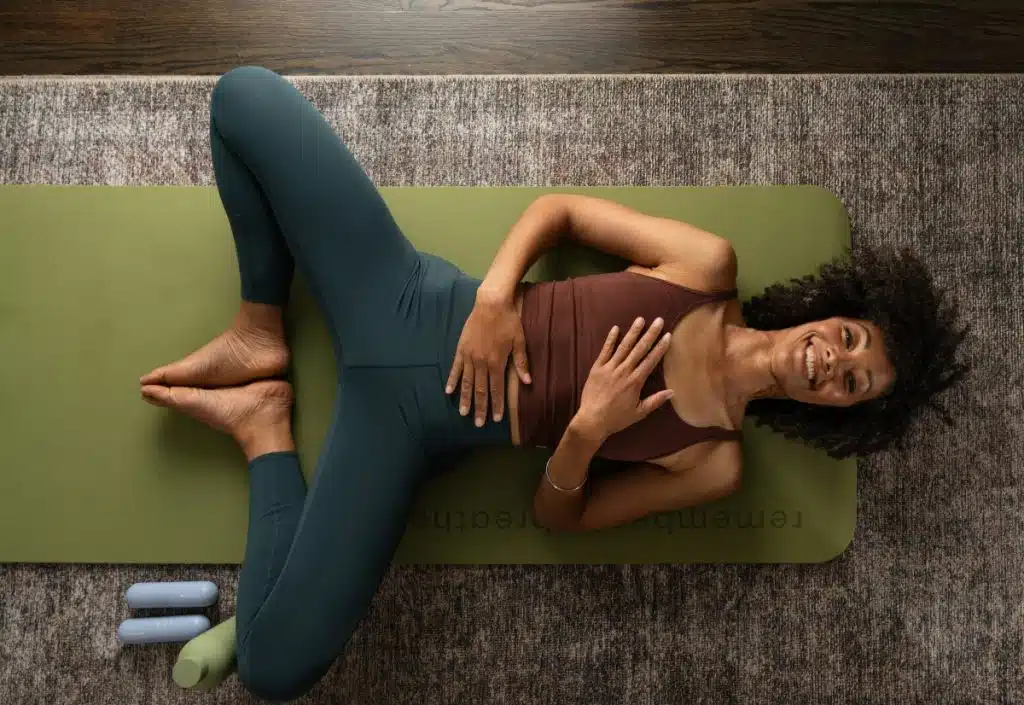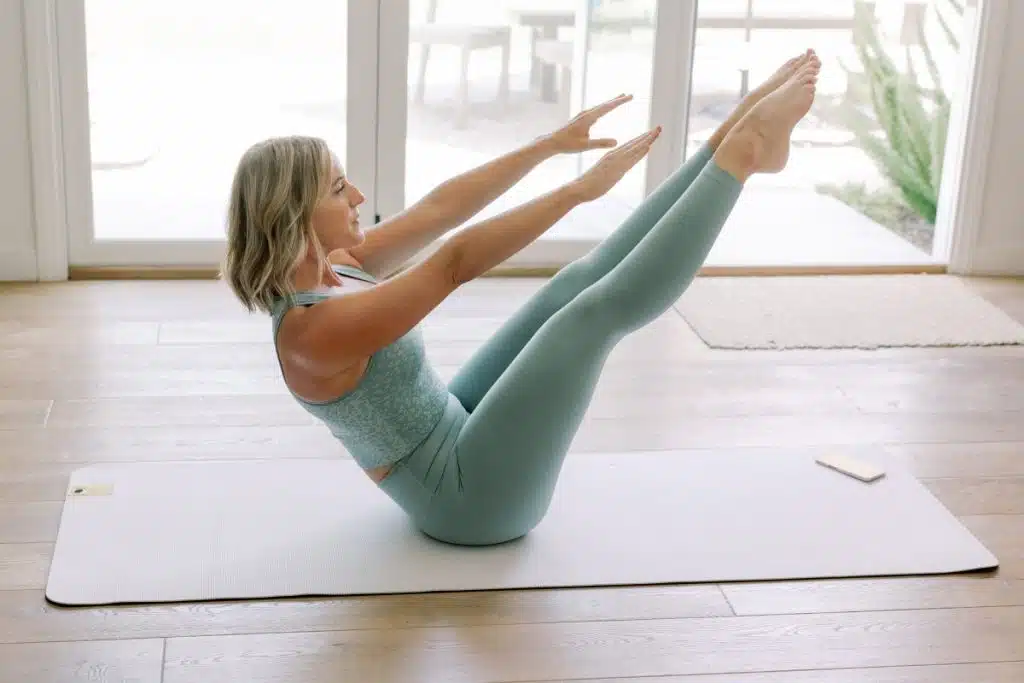
Deep core and pelvic floor exercises are some of the most important for your body, especially if you’re a woman. They’re the reason why I can still jump on a trampoline after having four children! (As long as I don’t have a full bladder and have to sneeze at the same time – ha!)
These exercises help you build strength that supports whole-body balance, a flexible range of motion, and postural alignment. A healthy core and pelvic floor also allow for hip and back mobility, greater sexual pleasure, and better digestion—all things most of us want!
If you’re doing core exercises only thinking about your “abs” though, you’re going to miss out on a lot of the benefits. At Lindywell, our goal is to help you slow down, tune in, and use that focus to be more intentional with movement to help you maximize the benefits.
This type of mindful movement is especially important with deep core and pelvic floor exercises. Let’s talk about why and then get into which exercises you should bring into your workout routine (hint: you won’t find any talk of crunches here).

What You Need to Know About Pelvic Floor Function
The pelvic floor is so important, and yet, for many women it’s a cause of discomfort, difficulty, or pain. Research shows that 32 percent of U.S. women will experience at least one pelvic floor issue in their lifetime. Here are some of the most prevalent ways that pelvic floor dysfunction can manifest:
- Incontinence: bladder leakage, painful urination, frequent urges, constipation, bowel strain, rectal pressure or discomfort
- Sexual Issues: painful intercourse, decrease in arousal or libido, infrequent orgasm
- Chronic Pain: back or pelvic muscle spasms, soreness or tightness in the lower back, hips, genitals, rectum, or pubic bone
Pelvic floor issues usually occur when something weakens this group of muscles, tears the connective tissue around it, or puts unnatural stress on the pelvic region. Whether that’s a procedure, event, or health condition, here are a few main culprits:
- Traumatic pelvic injuries
- Surgeries in the pelvic area
- Physical changes due to pregnancy
- Abdominal separation in childbirth
- Nerve damage in the pelvic area
- Untreated UTIs or vaginal infections
- Chronic pelvic inflammation
- Pelvic strain due to obesity
While pelvic floor dysfunction is common, you don’t need to accept it as “normal.” Instead, you can strengthen and heal this area of your body with deep core and pelvic floor exercises. If you’re experiencing visible and/or chronic symptoms, seeking the support of a medical professional might be advised and check out NIH’s guide to pelvic floor disorders to learn more.
5 Deep Core and Pelvic Floor Exercises
While chronic or severe cases of pelvic floor dysfunction might require medical intervention, many women experience restored functionality and lasting pain relief with Pilates. This happens as the result of the intentional breathing, postural realignment, and deep core strengthening aspects of this type of exercise.
You may be surprised to learn that rhythmic breathing is one of the most important aspects of Pilates for supporting pelvic floor health. On exhalation, the transversus abdominis (innermost core muscle) and pelvic floor draw into your midline. Then on inhalation, the diaphragm contracts to release and lengthen your pelvic floor.
In addition, the gentle, low-impact style of movement builds functional mobility, strength, balance, and flexibility. This means you’ll activate the core and pelvic floor with each intentional movement, alleviating tension while building strength.
However, you won’t get these results with basic abdominal exercises like crunches. Use these five deep core and pelvic floor exercises instead. For each exercise here, you can add resistance by squeezing a ball or towel between your knees. Get the full workout on YouTube and don’t miss the tips and suggestions below so you can get the most out of each movement.
Pelvic Floor Lift
The focus of this move is to contract and lift your pelvic floor muscles on each exhale, then lower and release them on each inhale. As you do this, think about pulling a tissue out of its box—that is the same motion you want to imitate with your pelvic floor.
Pelvic Curl
To perform this move correctly, contract the pelvic floor muscles as you use slow, controlled movement to raise your hips into a bridge, releasing as you return to the mat. For healthy pelvic floor function, it’s crucial to be able to maintain a fluid rhythm of contraction and relaxation.
Bent Knee Fall Out
When hinging your each leg out to the side, think about the motion of opening a book. Your core and hips stay stable, like the spine of a book, as your leg (the page) opens. The goal of this move is to create stability in the pelvic floor.
Seated Spinal Twist
As you twist from side to side, focus on keeping the pelvic floor muscles as stable and stationary as possible. This movement should be coming from your core, using those muscles to twist, hold, and return to center, rather than using your arms or hips.
Standing Chair Squat
As you do this movement, remember that your knees will bend, but they should not protrude in front of you. The focus of this squat variation is to release the pelvic floor widen the sit bones as you squat, and activate and lift the pelvic floor as you return to standing.
Strengthen Your Core and Pelvic Floor
Whether you feel discomfort in the pelvic floor region or you want to strengthen this area to help avoid future issues, Pilates is a solution you shouldn’t overlook. Work these exercises into your current daily or weekly movement routine and remember to go at your own pace. At Lindywell, we remind all of our members to meet their body where it’s at and build from there.
Get access to 300+ fun and effective Pilates classes to support your whole body (and mind!), with a 14-day free trial! As a member, you get all the workouts plus a library of guided breathwork sessions and nourishing recipes.








2 thoughts on “5 Deep Core and Pelvic Floor Exercises (That Don’t Involve Kegels)”
I signed up for the nutrition zoom today. Waited almost 15 min for it to start then logged off. Was pretty disappointed.
While the nutrition class started on time, we’re really sorry that you were unable to join and for the disappointment this caused! The great news is that everyone who registered was also emailed a replay. If you did not receive your email, please reach out to our Care Team at [email protected] and we will be happy to help you further!